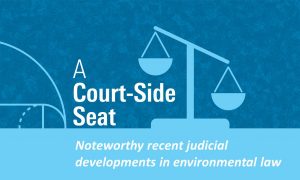Our latest look at the judiciary is focused mainly on the federal appeals system, with a side of regulatory development thrown in for good measure.
The U.S. Court of Appeals for the Third Circuit—Baptiste et al. v. Bethlehem Landfill Company
In this case, decided on July 13, 2020, the plaintiffs, neighbors of the Bethlehem Landfill, claimed that the operations of the landfill seriously interfered with the enjoyment of their homes, and resulted in a loss in their property values because of noxious odors. The lawsuit was grounded in Pennsylvania common law torts—public nuisance, private nuisance and negligence. The landfill is located on 224 acres and receives tons of waste on a daily basis which, as it decomposes, generates extremely noxious odors that are allegedly unbearable. The plaintiffs have asked for $5 million in property damages and other relief. The landfill is subject to extensive regulation by the Pennsylvania Solid Waste Disposal Act, and the rules of the Pennsylvania Department of Environmental Protection. However, since the statute does not provide a private right of action, the plaintiffs have resorted to the state common law remedies. The lower court dismissed the lawsuit, a decision the Third Circuit has now reversed. The appeals court held that the complaint was well pleaded and the case should be tried. The court noted some environmental justice concerns, but did not rely on these factors. The case was remanded to the trial court.
The U.S. Court of Appeals for the Ninth Circuit—Northern Alaska Environmental Center v. U.S. Department of the Interior
Decided July 10, 2020, this is an appeal from the lower court’s grant of summary judgment to several agencies involved in the 2017 offers and sale of oil and gas leases in the National Petroleum Reserve—Alaska. An Environmental Impact Statement (EIS) was prepared in 2012 for all BLM-managed lands in the Reserve. A separate EIS was not prepared for the 2017 lease sale, and the issue before the appeals court was whether the older EIS was sufficient. The court held that it was after reviewing the 2012 “programmatic” EIS. This EIS, for purposes of NEPA compliance, could support both broad-scale and site-specific projects, and is consistent with Ninth Circuit precedent.
The U.S. Court of Appeals for the District of Columbia Circuit
State of New York, et al. v. EPA
On July 14, 2020, the court rejected the Environmental Protection Agency’s (EPA) handling of a “Good Neighbor” Clean Air Act petition filed by the State of New York requesting relief from the industrial air emissions released from several “upwind states.” Because of these emissions, the State of New York has had great difficulty in satisfying the EPA’s 2008 and 2015 NAAQS standards for ozone. The EPA reviewed the petition in accordance with a four-step framework developed by the agency in its implementation of the interstate transport of ozone rules and procedures. The court held that the EPA’s explanation for its decision was unsatisfactory, and the burden of proof laid upon the State by the EPA’s procedures was impossible to carry. The matter was remanded to the agency to correct these deficiencies.
Standing Rock Sioux Tribe v. U.S. Army Corps of Engineers
In a case involving the Dakota Access Pipeline, the trial court handling this litigation ordered the owner of the pipeline to shut down its operational pipeline running underneath Lake Oahe within 30 days. It had held that the Corps of Engineers easement decision was not supported by an EIS, causing the lower court to vacate the easement. However, the District of Columbia Circuit has stayed that action to give the court sufficient time to review this action.
The U.S. Court of Appeals for the Fifth Circuit—Houston Aquarium, Inc. v. Occupational Safety and Health Review Commission
On July 15, 2020, the court reversed an order of the Occupational Safety and Health Review Commission that the Houston Aquarium was in violation of the Occupational Safety and Health Administration (OSHA) workplace safety rules regulating commercial diving operations. The Aquarium features many large animals in its many tanks. To feed these animals and to clean the tanks, the Aquarium has many certified commercial divers on staff. An anonymous complaint was made to OSHA about these activities, and an investigation followed. The Aquarium was cited, and the citation was upheld by the Administrative Law Judge and the Commission, which concluded that the OSHA rules applied. However, the Fifth Circuit held that the rule’s “scientific diving exception” applied, based on the rule’s definitions, the agency’s guidelines and regulatory history.
Some Regulatory Notes
EPA’s revised Clean Water Act Section 401 State Certification rules were published on July 13, 2020 and are effective on September 11, 2020. (See 85 FR 42210.) The rules update and clarify the states’ water quality certification authority with respect to federal permitting requests.
The Council on Environmental Quality has published its revised NEPA procedural rules. These rules become effective on September 14, 2020. (See 85 FR 43304 (July 16, 2020).)
RELATED ARTICLES
 Gravel2Gavel Construction & Real Estate Law Blog
Gravel2Gavel Construction & Real Estate Law Blog



